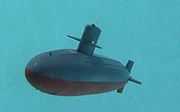Radio-controlled submarine
A Radio-controlled submarine is a scale model of a submarine that can be steered via radio control. The most common form are those operated by hobbyists. These can range from inexpensive toys to complex projects involving sophisticated electronics. Oceanographers and the Military also operate radio-controlled submarines.
Hobby Submarines

Dynamic diving
These models are positively buoyant, and will remain on the surface until sufficient thrust is generated over their control surfaces to force them down beneath the water. Dynamic diving models are both the cheapest and simplest designed models available, as complicated buoyancy control systems are replaced by diving planes or thrusters. Dynamic dive models also have the advantage of being able to return to the surface if radio contact is lost, due to their positive buoyancy. However, as they are positively buoyant, such models must maintain sufficient speed while underwater to remain there, and are unable to stop without rising to the surface. Some modelers may also argue that the speed required to submerge such models is not to scale and that they may dive too quickly.
Static diving
These models have the ability to alter their displacement by taking on or pumping out water. This can be accomplished through the use of a piston, inflatable bladder, or through a ballast tank. Boats that use a ballast tank generally fill the tank by opening a vent at the top, and force the water out by using compressed gas. There are variants that use water pumps for both processes. A liquid gas is dosed into the ballast tank to push water out. Gas-Snort Liquid gas is used to surface the boat in an emergency, otherwise the ballast tank is blown by the use of a snorkel tube at periscope depth and the boat is trimmed to surface to periscope depth with a full ballast tank. RCABS -Recirculated Compressed Air Ballast System. Originally developed by Darnell (UK) in the 1950s, this system uses a rubber bladder as the ballast tank and this is filled with compressed air supplied by a small compressor. The air is taken from the water-tight container (WTC) aft dry space to inflate the bladder.
Another system gaining popularity is the 'Snort System'. A ballast tank allows water to enter by releasing a vent valve on the top of the cylinder, allowing the boat to submerge. To surface, a small pump 'Snorts' air from the snorkel tube in the conning tower (sail) into the ballast tank, expelling the water. This system is also equipped with a small tank of compressed gas, which in the event of a fail-safe system operating, usually due to loss of radio signal, the gas is released into the ballast tank, surfacing the boat.
In Europe, the piston tank is the ballast system of choice. These models can become very expensive to build due to the complexity of their ballast systems. It should also be noted that in the event of a loss of radio contact while submerged, the boat will most likely sink to the bottom and require manual retrieval, unless equipped with a fail safe system. However, the ability to dive while at a stand still has its advantages, as it can be more precise and scale like than dynamic systems.
External links
- The SubCommittee
- Submarine modelers Forum
- Explorer sub made from PVC pipe(Spanish)
- R/C Model Submarines & Submersible Video Platforms
| ||||||||||